Zoom
Trash

Yuezhi. The Yuezhi or Rouzhi (Chinese: 月氏; pinyin: Yuèzhī) were an ancient Indo-European people[5][6] often identified with the Tókharoi (Τοχάριοι) of Classical sources.
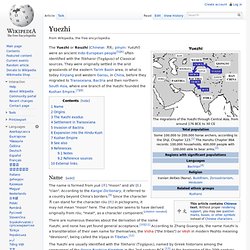
They were originally settled in the arid grasslands of the eastern Tarim Basin area, in what is today Xinjiang and western Gansu, in China, before they migrated to Transoxiana, Bactria and then northern South Asia, where one branch of the Yuezhi founded the Kushan Empire.[7][8] Name[edit] The name is formed from yuè (月) "moon" and shì (氏) "clan". According to the Kangxi Dictionary, it referred to a country beyond China's borders.[9] Since the character 月 can stand for the character ròu (肉) in pictograms, it may not mean "moon" here. The character seems to have derived originally from ròu, "meat", as a character component. According to the linguist J. Origins[edit]
Haplogroups « Through the mist of the past. Xinjiang is the north-western region of China, north of Tibet and at the same longitude than India.
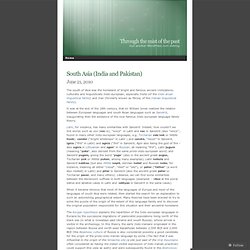
It is a very arid and desertic land. This region, also called Chinese Turkestan, is mostly inhabited by the Uyghurs, a Turkic-speaking population. May 2012. Salve, American Indians of the Plains are famous for their association with horses and horsemanship feats, but not seldom it is forgotten or omitted that often (the wholly nomadic tribes) and at times (in case of the earth or grass lodge dwellers) the entire household was also transported on horseback (and dog back) or pulled loaded on travois, especially during the golden era when the Comanches ruled the southern plains while various nations and tribes skirmished over the northern and central plains...
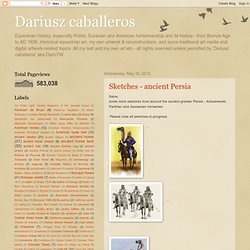
In pre-horse era of the Great Plains Indians cultures during the historic period (after 1500AD) their women were obviously the desired target of kidnapping/slaving parties carried by the enemy warriors, thus those women would become captives and slaves, and some eventually would change their status to adopted tribal members and wives to their captors. Well, there is a tale gathered from XIX century Blackfeet by an Anglo traveller named Julian Ralph. Old Sun and his wife: Mr. Ps. Mysterious Mummies of China. PBS Airdate: January 20, 1998Go to the companion Web site ANNOUNCER: Tonight on NOVA...
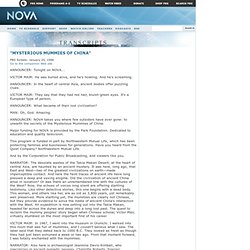
VICTOR MAIR: He was buried alive, and he's howling. And he's screaming. ANNOUNCER: In the heart of central Asia, ancient bodies offer puzzling clues. VICTOR MAIR: They say that they had red hair, bluish-green eyes. Chinese Pyramids. Lying about 7.5-miles southeast of Xi'an City in the rural countryside is a cluster of huge earthen pyramids, the existence of which remained largely unknown to the worldwide research community until only about 20-years ago.

With the recent liberalising of sanctions and the opening up of forbidden zones within China, which were formerly no-go zones to foreigners, increasing amounts of knowledge concerning China's ancient history are becoming accessible for the first time. With the tools now available through Google Earth satellite imagery, we can visit the various complexes of pyramids within China and measure them with good relative accuracy. APPENDIX II - Recent Discoveries Confirming the Irish Origins of Civilization... Introduction Was there a super-advanced culture in prehistory?
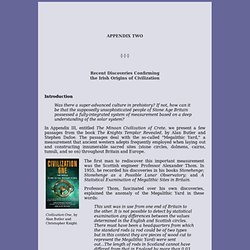
If not, how can it be that the supposedly unsophisticated people of Stone Age Britain possessed a fully-integrated system of measurement based on a deep understanding of the solar system? In Appendix III, entitled The Minoan Civilization of Crete, we present a few passages from the book The Knights Templar Revealed, by Alan Butler and Stephen Dafoe. The passages deal with the so-called "Megalithic Yard," a measurement that ancient western adepts frequently employed when laying out and constructing innumerable sacred sites (stone circles, dolmens, cairns, tumuli, and so on) throughout Britain and Europe.
Renfrew and Mallory on Y-DNA R1a1a, Irish, Tocharian and proto-Indo-European urheimat - Page 3 - ForumBiodiversity.com » Anthropology Biodiversity Forum (ABF) Originally Posted by Arch HadesC'mon dude you can't say things like that, it makes you look like a noob..I don't think so.
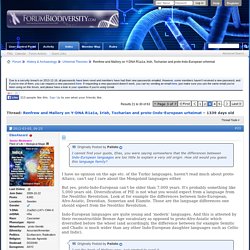
If anyone is a n00b, it's those who still use craniometrics and rely on it as if it were an exact science. Originally Posted by Arch Hadesthis is modern 21st century physical anthropology dude, Brace 2005 used 24 measurement variables. We aren't talking about Carleton Coonian 40s crap typology here.It's no different from the Coonian crap. I don't doubt that craniometrics has improved and gotten more accurate over the years.
Coon could be impressively accurate too; doesn't mean craniometrics can be used to determine the accuracy of biological descent. Renfrew and Mallory on Y-DNA R1a1a, Irish, Tocharian and proto-Indo-European urheimat - Page 6 - ForumBiodiversity.com » Anthropology Biodiversity Forum (ABF) Tocharian Manuscripts Online. Tocharian C - Page 2 - ForumBiodiversity.com » Anthropology Biodiversity Forum (ABF) Indo-European mummies in central Asia and China. Tall Caucasian Mummies of China. China's Tocharian mummies. Hunnoturk wrote: Acolyte wrote: I first read about these mummified remains years back, in a paper that was attempting to reset the ideas about the Aryans.

Hitler did them a severe disservice by trying to claim descent from them AND trying to say the Aryans were the Mohenjo-dorans. Ever since, there are racist issues when talking about the Aryans. IIRC, the Aryans were the people who later became known as Celts and other European tribes - they had a large empire of loosely confederated areas across all of Europe and a good part of Asia. The problem in that that the an ancient burial place of Celts, there is more in their blood haplogroup y-DNA i.In the same way business with burial places of Thracians is. I'm not sure I have made any hasty conclusions. Which ones are you talking about? I don't have a problem with Thracians and Celts being related. To me that suggests all their relatives in between those far-flung areas were pushed out or wiped out.
Does that fit with what you are saying? A dictionary of Tocharian B. Tocharian impact on South-Central Asia - ForumBiodiversity.com » Anthropology Biodiversity Forum (ABF) Originally Posted by Tocharian mummies tested so far are all R1a1a! You're confusing it with the Uyghur Y-DNA results. The Tarim mummies from 2000-1800 B.C.E. aren't IE. Mongoloid dynasties that ruled East Turkistan Tocharian and Central Asians.
Part 3: The Tocharian, Chapter 8: The Tocharian of Indochina.